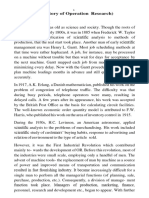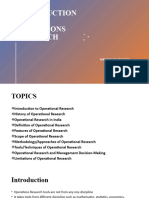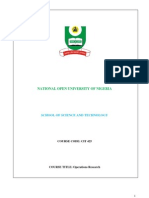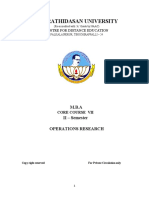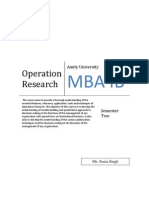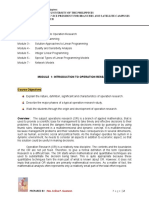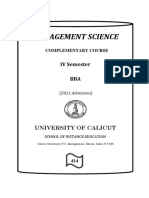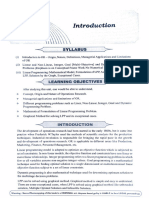0 ratings0% found this document useful (0 votes)
25 views32 pagesOperation Research Introduction
Operation research introduction
Uploaded by
AksCopyright
© © All Rights Reserved
We take content rights seriously. If you suspect this is your content, claim it here.
Available Formats
Download as PDF or read online on Scribd
0 ratings0% found this document useful (0 votes)
25 views32 pagesOperation Research Introduction
Operation research introduction
Uploaded by
AksCopyright
© © All Rights Reserved
We take content rights seriously. If you suspect this is your content, claim it here.
Available Formats
Download as PDF or read online on Scribd
You are on page 1/ 32
wr
Chapter - 1
( Historical Background of Operations
S Research
Historical Background of Operations Research
Historical Background of Operations Research
In United Kingdom McClosky and Trefthen firstly introduce the
term Operations Research in 1940, This is the new branch of the Science.
which came into existence in military context. during the Second World
War. Number of scientist experts from the related field were called for
military planning, by their joint efforts, experience and deliberations, they
suggested certain approaches that should be remarkable, This new
approach to systematic and scientific study of the operations of the
‘alled the Operations Research,
system was,
After the Second World War this new approach iy becomes a
popular and the complicated problem of economy industry was solved
with the help of Operations Research. Afterward number of Operations
Research techniques were find out by scientist Bazara M.S. & Shetty
CM. gives the details of foundation of the optimization techniques
Charnes A.. Cooper W.W. & Henderson A. gives the brief introduction to
this techniques.
During 1950 OLR. achieved recognition as a subject worthy of
academic study in the Universities. Since then the subject has been
gaining more and more importance for. students of Economies
Management, Public Administration, Behavioural Sciences. Social Work.
Mathematics, Commerce and Engineering. The theory of linear economic
models given by David Gale discuss above topics. Also some author
gives the details about the Operations Research they are as Hamdy A
Taha and Kanti Swarup, P.K. Gupta & Man Mohan
*Development of Operations Research :
This s
judy we can do in two part 1) Pre World War {f and 2) Post
World War Il. In which we can covers the details about the foundation of
Operations Research.
Historical Buckgromud of Operations Research 2
1) Pre World War IE : Operations Research roots are as old as,
science und society. Some author says that it’s roots are extend to even
early 1800's. In 1885 when Taylor emphasized the application of
scientific analysis to methods of productions. it was that the real start
took place.
At the same period Henry L. Gantt, give the job scheduling
problem. A job for instance, may be processed on a machine without
trouble but then wait for days for acceptance by the next machine. With
months in
the help of Gantt produce it is possible to plan machine-ladi
advance and still out delivery dates accurately
Another man A. K. Erlang a Danish mathematician published his
work on the problem of congestion of telephone traffic in 1917. The
problem is that during the busy periods, telephone operators were unable
to handle the calls the moment they were made it’s result becomes delay
of the calls. After that he develop the waiting time theory A. K. Erlang is
well known for the father of Queuing theory
In 1915 the well-known economic lot size model is attributed to
FW. Harris published his work on the area of inventory control. During
1930 H.C. Levinson, an American astronomer applied scientific analysis
to the problems of merchandising. His work included scientific study of
customer buying habits, response to advertising and relation of
environment to the type of article sold. It was the first: Industrial
Revolution. which contribute mainly towards the development of
Operations Research.
Industrial development brought with it, a new type of problems
called executive type problems. These problems are a direct consequence
of functional division of above in all organization. In an organization,
each functional unit either department or s
ction performs a part of the
whole job and for its suc
sstul working, develops its own objectives.
These objectives, though in the best interest of the individual department,
may not be in the best interest of the organization as a whole. These
Histurival Bass
You might also like
- Chapter One Introduction To Operations Research 1.1 History of Operations Research and Management ScienceNo ratings yetChapter One Introduction To Operations Research 1.1 History of Operations Research and Management Science24 pages
- MBA - Operations Research For Managers - Unit 1 - Introduction To Operations ResearchNo ratings yetMBA - Operations Research For Managers - Unit 1 - Introduction To Operations Research31 pages
- Quantitiative Methods-Operation ResearchNo ratings yetQuantitiative Methods-Operation Research38 pages
- Effect of "Operations Research" in Science and Industry: I J C R BNo ratings yetEffect of "Operations Research" in Science and Industry: I J C R B7 pages
- Republic of The Philippines: Ma. Celina P. GuanzonNo ratings yetRepublic of The Philippines: Ma. Celina P. Guanzon11 pages
- Operations Research A Practical Approach-24-25No ratings yetOperations Research A Practical Approach-24-252 pages
- Lecture 3 - Introduction To Operations Research IIINo ratings yetLecture 3 - Introduction To Operations Research III10 pages
- L-1 - 2 or Introduction To Operation SresearchNo ratings yetL-1 - 2 or Introduction To Operation Sresearch48 pages
- Introduction To O R - Good To Read Handout100% (1)Introduction To O R - Good To Read Handout222 pages
- Pillar Climate Change Organisation Summits InternationalNo ratings yetPillar Climate Change Organisation Summits International24 pages
- Workshop On Machine Learning 21 25 Dec 2024 1No ratings yetWorkshop On Machine Learning 21 25 Dec 2024 16 pages
